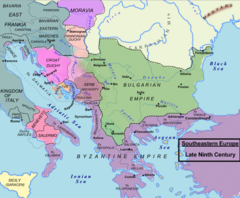Saint Naum
Saint Naum | |
|---|---|
Sveti Naum) | |
| Feast | 5 January and 3 July (Julian calendar), 20 May and 23 December (Revised Julian calendar, Gregorian calendar) |


Naum (
Biography
Information about his early life is scarce. According to the Second Life of Saint Naum he grew up in Moesia, which was the Byzantine designation for Bulgaria.[8] According to the hagiography of Clement of Ohrid by Theophylact of Ohrid and some other sources, Naum took part in the historic mission to Great Moravia together with Cyril and Methodius, their disciples Gorazd, Clement of Ohrid, Angelar and Sava and other Slavic missionaries in 863.[9]
Great Moravia and Lower Panonia
For the next 22 years, he worked with Cyril and Methodius and other missionaries in translating the
First Bulgarian Empire
In 886 the governor of
Cult
The cults towards saint Naum revered particularly in the region of Ohrid. It spread in the first half of the 18th century with the development of
Legacy
St. Naum Peak on Livingston Island in the South Shetland Islands, Antarctica is named for Saint Naum.
External links
- Virtual Panoramas of St. Naum in Ohrid
- Житие на Свети Наум; Жития на светиите. Синодално издателство, София, 1991 година, под редакцията на Партений, епископ Левкийски и архимандрит д-р Атанасий (Бончев). In English: Life of St. Naum, Vitaes of the Saints. St. Synod Publishing, Sofia, 1991, edited by Parthenios, Bishop Levkiyski and Archimndrite Dr. Athanasios (Bonchev).
References
- ISBN 0931922623, p. 56.
- ISBN 0-472-08149-7, p. 128.
- ISBN 0-88141-008-X.[1]
- ISBN 0-521-31950-1, p. 25.
- ISBN 0-8108-5565-8, p. 159.
- ISBN 0-8014-9493-1, p. 309.
- ISBN 0472081497, pp. 127-128.
- ISBN 9004168311, p. 161.
- ^ Kantor, Marvin (1983). Medieval Slavic Lives of Saints and Princes. The University of Michigan Press. p. 65.
- ISBN 1-85065-534-0, pp. 19-20.
- ISBN 0521273234, p. 5.
- ISBN 0521815398, pp. 221–222.
- ISBN 0810876027 p. 91.
- ISBN 0810875675, p. 342.
- ISBN 0521815398, p. 214.
- ^ Robert Elsie, The Christian Saints of Albania; Balkanistica, issue 13 (2000), pp. 35-57.
